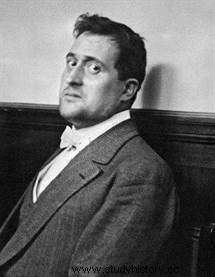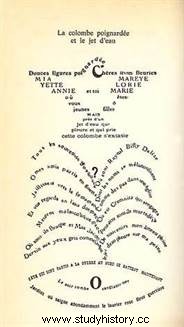 Short biography - Guillaume Apollinaire (1880-1918) is a French poet, pioneer of modern poetry. He is the inventor of the calligram (it is he who invents the name), a drawn poem. Guillaume Apollinaire lives at a pivotal time in French poetry. He knows the end of Symbolism and dies before the Dadaist and Surrealist revolutions, which his own innovative experience inspired. When the First World War broke out, Guillaume Apollinaire was mobilized. Wounded in the head by shrapnel, very weak, he died of the Spanish flu.
Short biography - Guillaume Apollinaire (1880-1918) is a French poet, pioneer of modern poetry. He is the inventor of the calligram (it is he who invents the name), a drawn poem. Guillaume Apollinaire lives at a pivotal time in French poetry. He knows the end of Symbolism and dies before the Dadaist and Surrealist revolutions, which his own innovative experience inspired. When the First World War broke out, Guillaume Apollinaire was mobilized. Wounded in the head by shrapnel, very weak, he died of the Spanish flu.
Guillaume Apollinaire, art critic and poet
Born in Rome on August 26, 1880, the son of a whimsical Polish aristocrat, Guillaume Apollinaris de Kostrowitzky grew up in Italy, then on the Côte d'Azur and Paris. Of an unknown father (probably an Italian officer), he was educated by his mother. A scholar, he became a tutor at Neuglück Castle in the Rhineland. This region and its folklore inspire his poetic universe. There he meets Annie Playden who introduces him to love, before rejecting it, which inspires him The Song of the Unloved , published in 1919. Back in Paris, a bank employee, he became a friend of the painter Pablo Picasso and the writers Max Jacob and Alfred Jarry.
From 1910 to 1914, he chronicled the exhibitions at L'Intransigeant. From 1912, he also directed his own magazine, Les Soirées de Paris, in which he exhibited his personal ideas. It was he who created the term “cubism” around 1911. He also maintained relations with the Italian Futurists, those painters who, under the leadership of the writer Marinetti, underlined the aggressiveness of modernity by representing machines. Finally, in many respects, Apollinaire appears as the precursor of Dadaism and Surrealism, especially with his Calligrammes , poems whose verses form a drawing.
The inventor of calligrams
 At first attached to the Symbolist movement, Guillaume Apollinaire gradually broke away from it to get involved in innovative artistic currents of the early 20th century. Some of his poems, related to the torments of his life (particularly in love) and written from 1898 to 1912, were collected in 1913, under the title of Alcools . With this collection of poems, Apollinaire upsets and renews the genre:his rhymes are approximate, his verses irregular and he enjoys breaking the classical poetic rhythm. What is even more surprising is the total absence of punctuation.
At first attached to the Symbolist movement, Guillaume Apollinaire gradually broke away from it to get involved in innovative artistic currents of the early 20th century. Some of his poems, related to the torments of his life (particularly in love) and written from 1898 to 1912, were collected in 1913, under the title of Alcools . With this collection of poems, Apollinaire upsets and renews the genre:his rhymes are approximate, his verses irregular and he enjoys breaking the classical poetic rhythm. What is even more surprising is the total absence of punctuation.
Apollinaire participated in the intellectual and artistic life of the capital at a time when cubism was being developed. He is already writing the "poems-conversations" that will form his Calligrammes (1918). The best known conveys the values of peace (The Stabbed Dove and the Jet of Water ). The dove symbolizes purity, peace stabbed by war. The first part of the poem recounts the memories of the poet's youth:the "dear flowery lips" of beloved young girls. The "but" breaks these images of softness, then introduces the jet of water which evokes his friends, poets and avant-garde painters who left for war, whose names "melancholy" in the throes of war, "O bloody sea and gardens where the warrior flower oleander bleeds abundantly”.
Guillaume Apollinaire was also interested in theater and journalism. He is also the author of poetic tales (The Rotting Enchanter , 1904), short stories (the murdered Poet , 1916) and erotic stories (Exploits of a young don Juan , 1907). His work influenced the greatest poets of the 20th century such as Paul Éluard, Louis Aragon or Jacques Prévert.
Apollinaris and war
In 1914, he wanted to enlist voluntarily in the army. As he was not yet a French citizen, his application was not accepted until eighteen months later. During the war, he fought with bravery. He shares the dreadful life of the infantrymen, but he does not give a realistic and exhaustive description of it. He only evokes the forehead through a poetry that remains confidential.
 His patriotic and exuberant war poems gloss over the horrors of battle and exalt life. They also reflect the pain of losing companions. Wounded by shrapnel in the temple on March 17, 1916, he had to undergo trepanation. During his long convalescence appears the Murdered Poet (1916) , a collection of short stories and tales that are both mythical and autobiographical. He still has Les Mamelles de Tirésias represented , a “supernaturalist” drama described as surrealist by Breton. He was finally killed by the Spanish flu on November 9, 1918, two days before the armistice. His funeral procession meets a victory parade.
His patriotic and exuberant war poems gloss over the horrors of battle and exalt life. They also reflect the pain of losing companions. Wounded by shrapnel in the temple on March 17, 1916, he had to undergo trepanation. During his long convalescence appears the Murdered Poet (1916) , a collection of short stories and tales that are both mythical and autobiographical. He still has Les Mamelles de Tirésias represented , a “supernaturalist” drama described as surrealist by Breton. He was finally killed by the Spanish flu on November 9, 1918, two days before the armistice. His funeral procession meets a victory parade.
Bibliography
- Guillaume Apollinaire, biography of Laurence Campa. Gallimard, 2013.
- Apollinaire. Portrait of a poet between two shores, by Philippe Bonnet. Blue &Yellow Editions, 2018.
- Guillaume Apollinaire:A War Biography 1914-1918, by Annette Becker. Tallandier, 2009.
